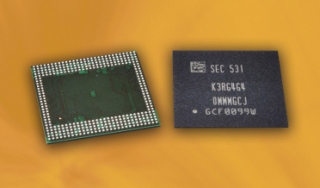Samsung Electronics Co., Ltd., announced today that it is mass producing the industry’s first 12-gigabit (Gb) LPDDR4 (low power, double data rate 4) mobile DRAM, based on its advanced 20-nanometer (nm) process technology.
 First 12Gb LPDDR4 – Samsung Opens Door for 6GB Mobile DRAM (Photo: Business Wire)
First 12Gb LPDDR4 – Samsung Opens Door for 6GB Mobile DRAM (Photo: Business Wire)
The newest LPDDR4 is expected to significantly accelerate the adoption of high capacity mobile DRAM worldwide. The 12Gb LPDDR4 brings the largest capacity and highest speed available for a DRAM chip, while offering excellent energy efficiency, reliability and ease of design – all essential to developing next-generation mobile devices.
“By initiating mass production of 12Gb LPDDR4 mobile DRAM in an extremely timely manner, we now are not only helping OEMs to accelerate their moves to the next generation of mobile devices, but also providing functionality that will give mobile consumers greatly enhanced user experiences,” said Joo Sun Choi, executive vice president of Memory Sales and Marketing at Samsung Electronics. “Furthermore, we intend to closely collaborate with our global customers to move beyond premium smartphones and tablets in creating new digital markets that embrace the full potential of cutting-edge technologies like next-generation mobile DRAM.”
Compared to the preceding 20nm-based 8Gb LPDDR4, the 12Gb version is more than 30 percent faster at 4,266 megabits per second (Mbps), and is twice as fast as DDR4 DRAM for PCs*, while consuming 20 percent less energy. In addition, manufacturing productivity of the 12Gb LPDDR4 has been raised more than 50 percent over that of 20nm-class** 8Gb LPDDR4, which will further fuel demand for higher memory capacity in flagship mobile devices.
The 12Gb LPDDR4 enables 3 gigabyte (GB) or 6GB of mobile DRAM in a single package using just two chips and four chips respectively, while being the only solution that can provide a 6GB LPDDR4 package. In next-generation flagship devices, 6GB of LPDDR4 mobile DRAM will allow consumers to enjoy seamless multitasking and maximum performance within the latest operating system (OS) environments. Also, based on the new 12Gb LPDDR4, the 6GB package can easily fit into the same space used for 3GB LPDDR4 packages currently available, therefore meeting the need for greater design compatibility and manufacturing productivity in advanced mobile devices.
By expanding its high-capacity memory product line based on 12Gb LPDDR4, Samsung plans to reinforce the competitiveness of its industry-leading 20nm DRAM lineup (12Gb/8Gb/6Gb/4Gb), while further solidifying the company’s position in the growing premium memory market.
Samsung also expects that due to the exceptional benefits of its LPDDR4 mobile memory, application areas will expand beyond smartphones and tablets to include ultra-slim PCs, digital appliances and automotive devices, in the coming years.
* Editor’s note: PC DDR4 DRAM processing speed per pin at 2,133Mbps.
** Editor’s note2: 20nm-class is a process technology node somewhere between 20nm and 30nm.